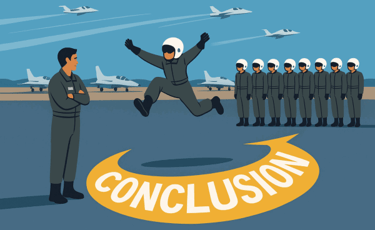Rare Story of a Flying Trainee's Jump to CONCLUSION
Read this short story and many more of my real-life experiences in my eBook



Jump to Conclusion
The year was 1988. I had joined the Naval Aviation as a Pilot. During my flying training, a hilarious incident happened. That day, I was planned for a solo check flying sortie with our Chief Flying Instructor or CFI in short, who is famous for his practical humor. He had an unusually thick moustache that covered all his upper lip. When he smiles, you see only his lower set of teeth.
I got briefed by the CFI for our 45-minute flight. Then we walked together to the hangar, where he signed in the aircraft form and accepted the aeroplane for flying. From there, we both marched towards the aircraft. As he did the external checks on the aeroplane, he told me to go to the cockpit and strap up in my seat.
This being a jet aeroplane, we had to strap up on an ejection seat. As the name suggests, an ejection seat will eject you from the aeroplane in case of a life-threatening emergency like a fire in air, engine seizure, etc. After ejection, the seat automatically separates from the pilot, and a parachute deploys, bringing the pilot down to the ground safely.
After the CFI came into the cockpit, he asked me to start the engine. Then, I did all the after-startup checks, took permission from Air Traffic Control or the ATC, and taxied out onto the runway. I took off on our training jet aircraft without any fuss. The CFI did not utter a word. I showed him all manoeuvres he had briefed me to perform in the flight. He had nothing to say.
Unfortunately, I had the habit of never looking at the ground from the air. The flying area around our flying training academy was divided into 5 sectors of 25 degrees each with a 5 degrees buffer zone between each of them.
To maintain flying within your sector allotted just before take off, you have to look in the map you carry with you in flight, for features like rivers, bridges, lakes, road railway line crossings, villages, and towns,, etc., Then look at the ground outside below the aeroplane and match them, to confirm that you are flying within your own allotted sector.
This is necessary because the adjacent sectors will have other aeroplanes flying. If you go into that adjacent sector, you might collide with the other aeroplane. Jet training aeroplanes are small and fast moving making ti difficult to spot them in the sky.
It was tough for me to spot these small bridges and road railway line crossings on the ground when I am flying at 20,000 feet up in the sky. So, I had found a way around this. I used to compare my Compass (direction indicator) and the ADF or the Automatic Direction Finder which fortunately were superimposed on each other in the cockpit instruments, to maintain my Sector when flying. If either the Compass or the ADF malfunctions, I am doomed. I cannot maintain my Sector.
But, all our flying instructors always wanted us to compare our map to the ground for maintain flying inside the sector. And that day I was flying with our Chief Flying Instructor. In no time, he found out my Compass ADF trick. But the CFI kept quiet. I completed the mission without any flaw and I was very confident that I had passed the test.
I turned towards the airfield and asked the ATC for a rejoin for landing. The CFI took over the aircraft control from me at that instant, banked the aircraft hard left with 60-degree bank angle to the left and said, "Son, do you see that lake below in our sector?"
I said, "Yes, Sir."
The CFI said, "Look at your map and tell me what the name of that lake is?"
I don't know why I said, "Banana lake, Sir."
The CFI immediately turned the aircraft towards the runway in silence. I knew I was caught that day. Since I was not used to comparing the map and ground, I had no idea which lake was in which sector. I took out the map and looked. I realized that we were flying in Sector no 1, and the Banana lake was in the Sector no 5. For the first time I noticed that lake was actually in the shape of a Banana in the map. The lake the CFI showed me to identify was actually Octopus lake, which was shaped like an Octopus, thanks to a few rivulets joining it from various directions.
I thought the Chief Flying Instructor was going to fail me in this flying test sortie for identifying Octopus lake as Banana lake. I kept thinking about this so much that I did not even realize that the CFI had already landed the aircraft and was in the dispersal and, switching off the engine.
I came out of the aircraft and did the after-landing external checks on the aeroplane. As we walked towards the aircraft Hangar, he stopped halfway on the tarmac and said, "Go, call all Flying Cadets here".
I went running and called everyone around. Then he told me to get a piece of Chalk. I ran to our classroom building and got the chalk piece. Everyone was there waiting for me.
Then the CFI said, "Write CONCLUSION in big capital letters."
I wrote CONCLUSION on the concrete tarmac in huge letters.
Then he said, "Now draw a Banana shape around the word Conclusion."
I drew the Banana Shape as ordered and stood up.
"Now jump to Conclusion that you have drawn a hundred times". Thundered the CFI.
I must have looked like a clown to all my friends who were gathered around.
A few seconds later, the Chief Flying Instructor started walking back to the aircraft Hangar. After a few steps, the CFI turned back and told all the other Cadets, "Never jump to Conclusion like him", and walked away.
Everyone stood there and laughed. Some flying cadets even counted aloud till I completed my 100th jump to Conclusion. I was thoroughly tired both mentally and physically after that day's incident.
Contrary to my expectation of failing in that sortie, he passed me, despite the blunder I did.
Explore Captivating Rare Stories from my life
© 2025. All rights reserved.
